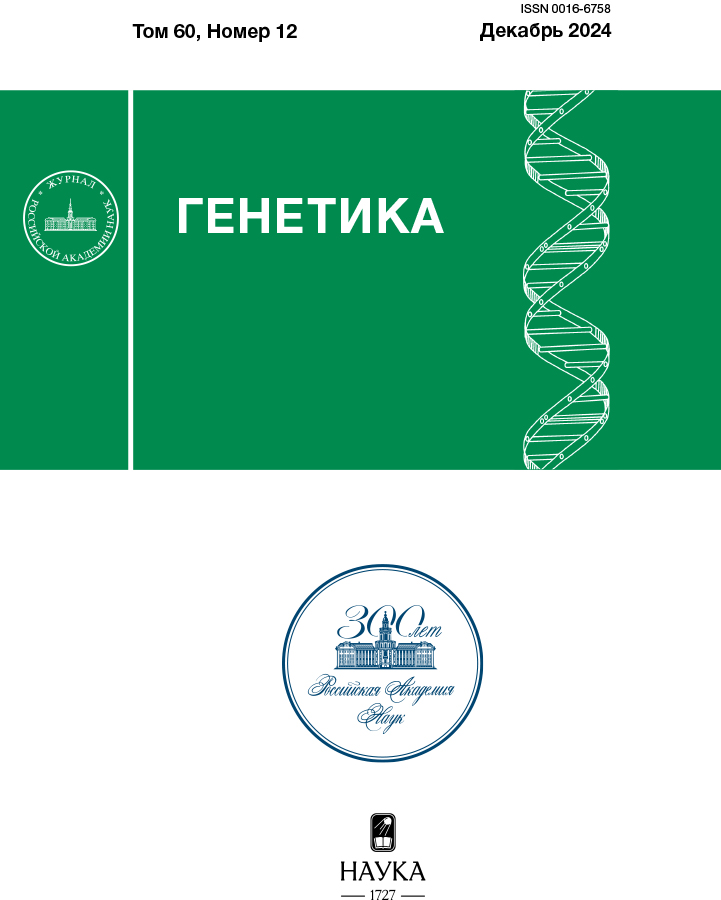Characteristics by str Markers of gray Ukrainian Cattle Breed in the Russian Federation
- Авторлар: Mokeev A.S.1, Fursa N.N.1, Beketov S.V.2, Svishcheva G.R.2, Onokhov A.A.2, Stolpovsky Y.A.2
-
Мекемелер:
- Ivanov Institute of Livestock Husbandry of Steppe Regions “Askania-Nova” – National Scientific Selection and Genetic Center for Sheep Breeding of the National Academy of Agrarian Sciences
- Vavilov Institute of General Genetics of Russian Academy of Sciences
- Шығарылым: Том 60, № 12 (2024)
- Беттер: 75–82
- Бөлім: ГЕНЕТИКА ЖИВОТНЫХ
- URL: https://kld-journal.fedlab.ru/0016-6758/article/view/676597
- DOI: https://doi.org/10.31857/S0016675824120081
- EDN: https://elibrary.ru/waagjv
- ID: 676597
Дәйексөз келтіру
Аннотация
Using 14 microsatellite markers (BM1824, BM2113, CSRM60, CSSM66, ETH3, ETH10, ETH225, ILSTS006, INRA023, SPS115, TGLA53, TGLA122, TGLA126, TGLA227), samples of Ukrainian Grey cattle herds of the M.F. Ivanov Institute “Askania-Nova” (Kherson region) (n = 101) and experimental farm of Cherga (Altai Republic) (n = 41). When considering Wright's F-statistics for the studied loci, the value FIS = –0.0285 indicates an excess of heterozygous genotypes in the population of Ukrainian Grey cattle, with a low probability of encountering alleles of the common ancestor FIT = 0.1161, and the level FST = 0.1394 indicates an average divergence of subpopulations, the largest contribution to which is contributed by the Eth3 locus. At the same time, the number of detected polymorphic loci – 95.64%, the level of allelic diversity – AR = 7.66 and genetic diversity – HE = 0.76 were higher in the Altai subpopulation than in the Kherson subpopulation – 58.13%, 4.41, 0.61, respectively. At the same time, the Kherson herd was characterized by better evenness, homogeneity and consolidation, which allows us to consider it as a source of valuable breeding material for breeding the Ukrainian Grey breed.
Толық мәтін
Авторлар туралы
A. Mokeev
Ivanov Institute of Livestock Husbandry of Steppe Regions “Askania-Nova” – National Scientific Selection and Genetic Center for Sheep Breeding of the National Academy of Agrarian Sciences
Хат алмасуға жауапты Автор.
Email: mokeev.as@mail.ru
Ресей, Askania-Nova, 275230
N. Fursa
Ivanov Institute of Livestock Husbandry of Steppe Regions “Askania-Nova” – National Scientific Selection and Genetic Center for Sheep Breeding of the National Academy of Agrarian Sciences
Email: mokeev.as@mail.ru
Ресей, Askania-Nova, 275230
S. Beketov
Vavilov Institute of General Genetics of Russian Academy of Sciences
Email: svbeketov@gmail.com
Ресей, Moscow, 119991
G. Svishcheva
Vavilov Institute of General Genetics of Russian Academy of Sciences
Email: svbeketov@gmail.com
Ресей, Moscow, 119991
A. Onokhov
Vavilov Institute of General Genetics of Russian Academy of Sciences
Email: svbeketov@gmail.com
Ресей, Moscow, 119991
Yu. Stolpovsky
Vavilov Institute of General Genetics of Russian Academy of Sciences
Email: svbeketov@gmail.com
Ресей, Moscow, 119991
Әдебиет тізімі
- Столповский Ю.А. Серая украинская порода // Генетические ресурсы крупного рогатого скота: редкие и исчезающие отечественные породы. М.: Наука, 1993. С. 94–111.
- Glazko V.I. Podolic сattle in the Ukraine and eastern territories // Stočarstvo: Časopis za unapređenje stočarstva. 2001. V. 55. № 1. Р. 33–60.
- The state of the world’s animal genetic resources for food and agriculture. Rome, FAO, 2007. 511 р.
- Ukrainian grey/Ukraine (cattle). Domestic animal diversity information system of the food and agriculture organization of the United Nations. Accessed April 2023. https://www.fao.org/dad-is/browse-by-country-and-species/en/
- Dakin E.E., Avise J.C. Microsatellite null alleles in parentage analysis // Heredity. 2004. V. 93. P. 504–509. doi: 10.1038/sj.hdy.6800545
- Olschewsky А., Hinrichs D. An overview of the use of genotyping techniques for assessing genetic diversity in local farm animal breeds // Animals. 2021. V. 11. № 7. P. 2016. https://www.mdpi.com. doi: 10.3390/ani11072016
- Бекетов С.В., Семина М.Т., Мокеев А.С. и др. Перспективы применения технологии “генетического биркования” в животноводстве // Главный зоотехник. 2024. № 5. С. 3–15.
- Jombart T. Adegenet: A R package for the multivariate analysis of genetic markers // Bioinformatics. 2008. V. 24. P. 1403–1405. doi: 10.1093/bioinformatics/btn129
- Keenan K., McGinnity P., Cross T.F. et al. diveRsity: An R package for the estimation and exploration of population genetics parameters and their associated errors // Methods Ecol. and Evol. 2013. № 4. P. 782–788. doi: 10.1111/2041-210X.12067
- Adamack A.T., Gruber B. PopGenReport: Simplifying basic population genetic analyses in R. Methods // Ecology and Evolution. 2014. № 5. P. 384–387. doi: 10.1111/2041-210X.12158
- Gruber B., Adamack A.T. landgenreport: A new R function to simplify landscape genetic analysis using resistance surface layers // Mol. Ecol. Resources. 2015. V. 15. P. 1172–1178. doi: 10.1111/1755-0998.12381
- Кушнир А.В., Глазко В.И. Серый украинский скот и его близкородственные формы // Сиб. экол. журнал. 2009. Т. 16. № 3. С. 495–506.
- Копылов К.В., Стародуб Л.Ф., Мохначева Н.Б., Супрович Н.П. Особенности изменчивости генома крупного рогатого скота серой украинской породы по цито- и ДНК-маркерам // Акт. пробл. интенсивного развития животноводства. 2019. Вып. 1. С. 60–69.
- Holsinger K.E. Lecture notes in population genetics. Stanford: University of Connecticut, 2010. 275 p. doi: 10.6084/M9.FIGSHARE.100687
- Кузнецов В.М. F-статистики Райта: оценка и интерпретация // Пробл. биол. продуктивных животных. 2014. № 4. С. 80–104.
- Кузнецов В.М. Снижает ли кроссбридинг генетическое разнообразие? Разведение и сохранение пород молочного скота в России. Киров: НИИСХ Северо-Востока, 2017. 104 с.
- Кузнецов В.М. Сравнение методов оценки генетической дифференциации популяций по микросателлитным маркерам // Зоотехния. 2020. Т. 21. № 2. С. 169–182. doi: 10.30766/2072-9081.2020.21.2.169-182
- Гузеев Ю.В., Мельник О.В., Спиридонов В.Г., Мельничук С.Д. Сравнительный анализ генетической структуры микропопуляции серой украинской породы крупного рогатого скота по ДНК-маркерам // Науковий вісник ЛНУВМБТ імені С. З. Ґжицького. 2015. Т. 17. № 3(63). С. 166–171.
Қосымша файлдар













